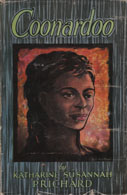 | Coonardoo Katharine Susannah Prichard 1929 |
This novel was co-winner of the 1928 "Bulletin" novel writing competition, and, interestingly, was submitted under the pen-name "Jim Ashburton"; which is hardly surpising given the book's subject matter. Also, oddly, the prize was shared with A House is Built, by M. Barnard Eldershaw - the pseudonym of Marjorie Barnard and Flora Eldershaw: two novels written by women winning a major literary prize in 1928, and both submitted under pseudonyms.
Coonardoo, the title character, is a young Aboriginal girl living on a cattle station, Wytaliba, in the north-west of Western Australia, in the early part of the twentieth century. Hugh, the young son of the station's owner, is sent away to school and while the early part of the novel sets the scenery, and foreshadows some of the personal conflicts that will arise later in the story, it is only when Hugh returns from school that the novel really gets going. Hugh's mother dies and he is left, in his early twenties, single and with a station to manage and run. The first of these problems is dealt with when Hugh returns from a holiday in Geraldton with a wife. The second will prove harder as drought and the tough countryside combine over the years to wear him down. But these are just a backdrop to the real story of this novel: the relationship between a native woman and a white man.
Much play is made early in the piece about Hugh's commitment to leave the Aboriginal women alone and find a white wife, a commitment that is at odds with the bulk of the European men in the district. He sticks to his promise in the main, except during a moment of disease and weakness when he seeks physical comfort in the arms of Coonardoo. As seems to always be the case with fiction, a child is born of this single liaison, and while Hugh doesn't openly claim Winni as his own, the affection he shows towards the boy is plain for all to see. Coonardoo stays mainly in the background of Hugh's life, managing his household and helping when and where she can. A succession of female children are born and Hugh's wife becomes more and more disenchanted with the hard, lonely station life until the two agree to a mutual separation. At this time, Coonardoo rightly believes she will become a more important part of Hugh's life, but, remembering his earlier promise, he avoids her physically and emotionally.
The great thing about this novel is that, apart from its convincing portrait of station life, it puts an Aboriginal character into a prominent position in an Australian novel. There is no sense of judgment from the author at any time: Coonardoo is shown as being both weak and strong, confused and emotional, but with a dignity that sustains her through a life of hardship and heartache. It must have come as something of a shock to most Australians who read this book when it was first published in 1929. It is an important book in the development of Australian literature and rightly deserves its place in this list.
Notes:
The full text of this book is not available as it it is still under copyright.
Katharine Susannah Prichard
Wikipedia page
Photo of the author
The next four works in this Classic Year:
16. 10 for 66 and All That by Arthur Mailey (1958)
17. Lucinda Brayford by Martin Boyd (1946)
18. A Fortunate Life by A.B. Facey (1981)
19. Picnic at Hanging Rock by Joan Lindsay (1967)
